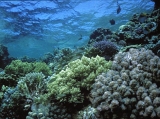Wednesday, April 12, 2006
NASA Helps Researchers Diagnose Coral Bleaching at Great Barrier Reef

An international team of scientists are working at a rapid pace to study environmental conditions behind the fast-acting and widespread coral bleaching currently plaguing Australia's Great Barrier Reef. NASA's satellite data supply scientists with near-real-time sea surface temperature and ocean colour data to give them faster than ever insight into the impact coral bleaching can have on global ecology.
Australia's Great Barrier Reef is a massive marine habitat system made up of 2,900 reefs spanning over 600 continental islands.
Scientists use ocean temperatures and ocean "colour" as indicators of what is happening with coral. Coral is very temperature sensitive. Ocean "colour," or the concentration of chlorophyll in ocean plants, is important because it informs scientists about changes in the ocean's biological productivity. NASA satellites capture both temperature and colour data from their space-based view of the coral reefs.
Bleaching occurs when warmer than tolerable temperatures force corals to cast out the tiny algae that help the coral thrive and give them their color. Without these algae, the corals turn white and eventually die, if the condition persists for too long.
NASA offer a free, Internet-based data distribution system that enables researchers around the globe to customize requests and receive ocean color data and sea surface temperature data.
--
Subscribe to SCUBA News (ISSN 1476-8011) for more free news, articles, diving reports and marine life descriptions - http://www.scubatravel.co.uk/news.html

Labels: coral